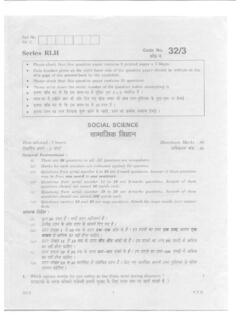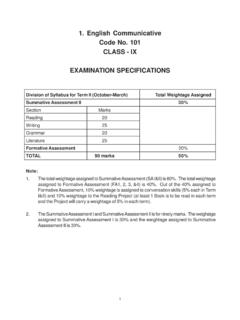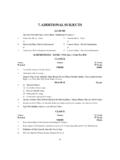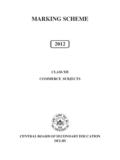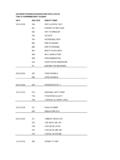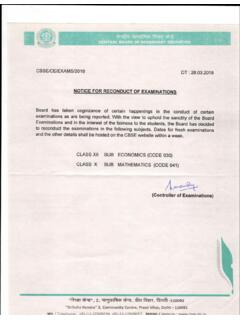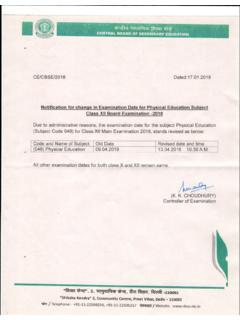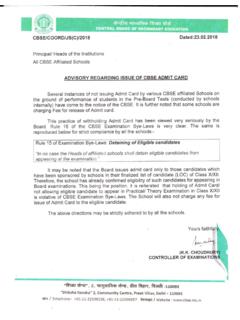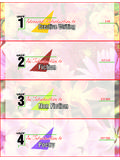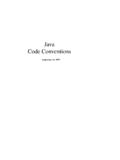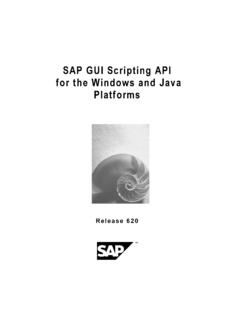Transcription of informatics - CBSE
1 informatics practices Learning Objectives: 1. To understand the application development environment. 2. To gain programming Skills in GUI Programming Tool and Database Creation in RDBMS. 3. To design, program and develop database application using GUI Programming Tool and RDBMS. 4. To learn database connectivity using Visual Basic as Front-end tool. 5. To develop ability to use the Open Source Technology. Competencies: 1. Student will become familiar with Application Development 2. Student will be able to develop & debug programs Independently. 3. Student can use SQL for storing and retrieving data from the RDBMS. 4. Ability to arrive at a normalized design of tables and other database objects in RDBMS.
2 5. Student will be able to develop a Client Server Application using Front end and Back end tools. Class XI (Theory). Duration: 3 hours Total Marks: 70. Unit No Unit Name Marks 1. COMPUTER SYSTEM AND BUSINESS APPLICATIONS 10. 2. INTRODUCTION TO PROGRAMMING 30. 3. RELATIONAL DATABASE MANAGEMENT SYSTEM 30. 70. UNIT 1: COMPUTER SYSTEM AND BUSINESS APPLICATIONS. Evolution of computers; Basics of computer and its operation: Functional Components and their inter-connections, concept of Booting;. Hardware concepts: Diagram illustrating main parts of computers;. Central Processing Unit (CPU): Arithmetic Logic Unit (ALU), Control Unit, Memory Unit (RAM - Random Access Memory & ROM - Read Only Memory).
3 Role of Input, Processing and Output Devices in a computer system Input devices: Keyboard, Mouse, Light pen, Touch Screens, Graphics Tablets, Joystick, Mic, MICR, OCR, Scanner, Smart Card reader, Barcode reader, Biometric sensor, web camera, digital camera;. Output Devices: Monitor/Visual Display Unit (VDU), Printer (Dot Matrix Printer, Desk jet/ Ink jet/ Bubble jet Printer, Laser Printer), Plotter, Speaker, Secondary Storage Devices: Floppy Disk, Hard Disk, Compact Disk, Magnetic Tape, Digital Video Disk (DVD), Zip Drive; Units of Memory: Bit (Binary Digit), Byte, Kilobyte, Megabyte, Gigabyte. Software Concepts: Types of Software: System Software, Utility Software and Application Software.
4 System Software: Operating System, Language Compilers, Interpreters and Assembler;. Operating System: Need of operating systems, Functions of Operating System Types of operating system. Utility Software: Compression tools, Anti Virus, File Management tools and Disk Management tools;. Application Software as a tool: Word Processor, Presentation Tool, Spreadsheet Package, Database Management System; Business software (for example: Inventory Management System, Payroll System, Financial Accounting, Hotel Management, and Reservation System);. Development of programming languages - Machine Language, Assembly Language, High Level Language (BASIC, COBOL, FORTRAN, PASCAL, C++); GUI based languages - Visual Basic, Visual C++; C#, Java, CBSE 1.
5 GUI Operating System Important: Students/Teachers can also perform similar operation on any operating system. It is advised that the teacher while using any one operating system, give a demonstration of equivalent features for the other operating system. Windows General features, Elements of Desktop - Taskbar, Icon, Start button, Shortcuts, Folder, Recycle Bin, My Computer;. Start Menu: Program, Documents, Settings, Find/Search, Help, Run, Shut Down/Logoff;. Customization of Taskbar, start menu, Display properties (Wallpaper, Font Settings, Color Settings, Screen Savers);. Program Menu: Accessories - Calculator, Notepad, Paint, Word pad, Entertainments (CD Player, Sound Recorder, Media Player, Volume Controller); Internet Browsers Mozila Firefox, Internet Explorer, Netscape Navigator.
6 Control Panel: Add new hardware; Add new Software, Printer Installation, Date/Time, Mouse, and Regional Settings;. Documentation Purpose of using word processing software, opening a new/existing document, closing a document, typing in a document, saving a document, print preview, printing a document, setting up of page as per the specifications, selecting a portion of document, copying selected text, cutting selected text, pasting selected text; changing font, size, style, color of text; Inserting symbol; Formatting: Alignment Left, Right, Center; Justification;. Industries and Business Computing: Types of Industries (Production, Shipping, Travel, Hotel, Insurance, Construction, Automobile), Applications of Business Computing in Industries.
7 UNIT 2: INTRODUCTION TO PROGRAMMING. Programming Methodology: General Concepts; Modular approach; Stylistic Guidelines: Clarity and Simplicity of Expressions, Names, Comments, Indentation; Documentation and Program Maintenance; Running and Debugging programs, Syntax Errors, Run-Time Errors, Logical Errors;. Problem Solving Methodology and Techniques: Understanding of the problem, Identifying minimum number of inputs required for output, Step by step solution for the problem, breaking down solution into simple steps, Identification of arithmetic and logical operations required for solution, Using Control Structure: Conditional control and looping (finite and infinite).
8 Programming Tool: Visual Basic Introduction to Programming Modular Programming, Object Oriented Programming, Event Driven Programming;. About Visual Basic (Object Based Programming Language), Rapid Application Development using Visual Basic;. Concept of Project in Visual Basic, VB Project Options - Standard EXE, ActiveX DLL, ActiveX EXE, ActiveX Control, ActiveX Document DLL, ActiveX Document EXE, Addin, VB Application Wizard, IIS Application, DHTML Application;. Getting Familiar with Visual Basic User Interface - Pull-Down menus, Toolbar, Toolbox, Project Explorer, Properties Window, Form Layout window, Form, Immediate window.
9 Opening and Closing windows, Resizing and moving windows, Docking windows; Quitting Visual Basic;. Visual Basic Tool Box (Standard Window Controls) - Pointer, Picture Box, Label, Text Box, Frame, Command Button, Check Box, Option Button, Combo Box, List Box, Horizontal Scrollbar, Vertical Scrollbar, Timer, Drive List box, Directory List box, File List box, Shape, Line, Image, Data, OLE;. Object Naming Conventions, Event Procedures;. Programming Fundamentals Data Types: Integer, Long, Single, Double, Currency, String, Byte, Boolean, Date, Object, Variant;. Variables: Need to use variable, Declaring Variables, Variable Naming Convention, Assigning value to Variables, Data Types of variable, Scope and lifetime of Variables (Public and Private).
10 Menu Editor: Concept of Menus, Shortcut menus and Popup menus Designing Menu System, Menu Editor Dialog Box Options (Name, Index, Shortcut, HelpContextID, NegotiatePosition, Checked, Enabled, Visible, WindowList, Right Arrow, Left Arrow, Up Arrow, Down Arrow, Menu List, Next, Insert, Delete, OK, Cancel), To Create Menu Controls in the Menu Editor, Menu Naming Conventions, Setting the Name Property, Creating a Menu Control Array, Creating Sub Menus, Separating Menu Controls, Assigning Access Keys and Shortcut Keys, Controlling Menus at CBSE 2. Runtime-Enabling and Disabling Menu Commands, Displaying a Checkmark on a Menu Control, Making a Menu Control Invisible, Adding Menu Control at Runtime, Displaying Pop-Up Menu.
